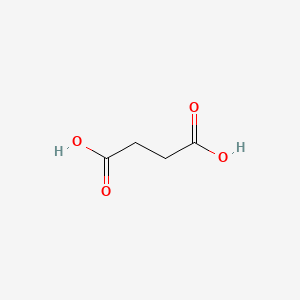Succinic acid (butanedioic acid) is a dicarboxylic acid that occurs naturally in plant and animal tissues. The chemical is also known as "Spirit of Amber." When it was first discovered, it was extracted from amber by pulverizing and distilling it using a sand bath.
C4H6O4. National Center for Biotechnology Information. PubChem Compound Database; CID=1110, https://pubchem.ncbi.nlm.nih.gov/compound/1110 (accessed July 1, 2018).
【Succinic Acid】
Rating: GOOD
Benefits: Soothing, Anti-Acne
Categories: pH Adjuster/Stabilizer, Chelating Agent
Succinic acid is a synthetic or biofermented ingredient that’s primarily used in cosmetics to adjust pH, serve as a chelating agent, and mask unpleasant odors (although it doesn’t contain fragrance components).
This ingredient is often touted for helping with acne, although such marketing claims aren’t strongly supported by scientific research. It’s helpful potential is more indirect, but more definitive research is needed. This fact is why Paula’s Choice Skincare hasn’t formulated with succinic acid and has no future plans to do so.
In terms of succinic acid’s connection to breakouts, research has shown that a strain of bacteria on skin known as S. epidermidis produces succinic acid in order to naturally reduce the population of C. acnes bacteria. However, it’s not certain if the succinic acid is working alone or in tandem with other bacteria comprising skin’s microbiome.
Other research has shown succinic acid might be helpful for breakouts because it disrupts the intercellular pH of the C. acnes strain; however, it’s not as potent or thorough in this regard as the gold standard acne ingredient benzoyl peroxide. Keep in mind that too much succinic acid may have a toxic effect on skin cells due to its high acidity (its natural pH hovers around 1, which is highly acidic). To counter this, it must be buffered in solution to pH 3.5 or greater. This has been the case with succinic acid-containing skin care products we’ve encountered to date.
Animal research done on mice has shown topical use of fermented succinic acid reduces the inflammation triggered by acne-causing bacteria. However, other research has found that succinic acid does not have such properties, one more reason to not consider it instead of many other soothing skin care ingredients that have unanimous positive research behind them.
Usage levels of succinic acid in skin care are typically 1–5%. It may be used in the same formula with salicylic acid, since the benefits of both depend on a more acidic pH range.
https://www.paulaschoice.com/ingredient-dictionary/ingredient-succinic-acid.html

